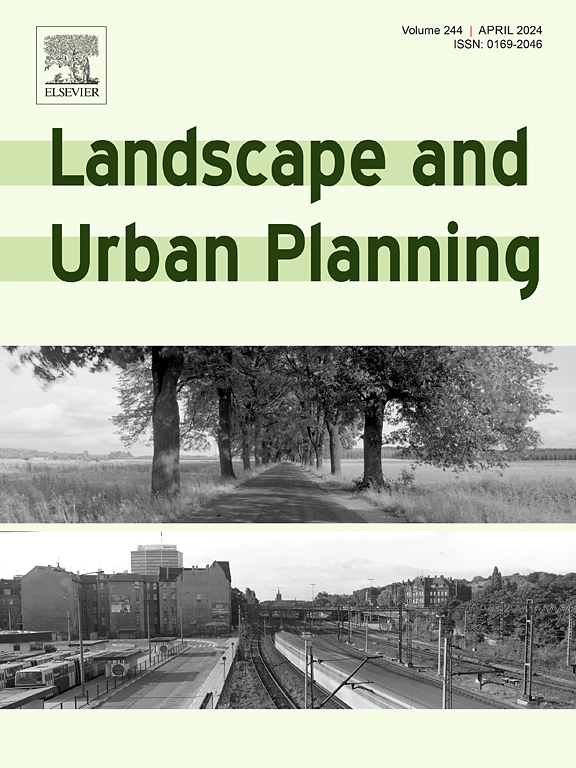以自然为基础的解决方案规划变革:斯德哥尔摩的地理设计应用
IF 7.9
1区 环境科学与生态学
Q1 ECOLOGY
引用次数: 0
摘要
迈向人类社区和生态系统都能蓬勃发展的城市未来,需要变革(TC)。空间规划可以作为激发和促进城市预期转型的支柱。然而,为了支持这种转变,空间规划面临的挑战是创建非常规的规划,通过参与式程序考虑到不同场景的复杂权衡和相互作用。解决这一挑战的一个很有前途的方法是地理设计,因为它将空间协同设计与撞击模拟相结合。本文旨在探讨地理设计过程如何支持共同创建变革性城市规划,从而在实现城市发展目标的同时增强生物多样性和生态系统服务。为瑞典斯德哥尔摩的一个案例研究社区开发并部署了地理设计过程。我们开发了两个场景故事线:一个是遵循当前的城市规划,另一个是进一步强调规划中最具变革性的元素。分成三组的14名规划利益相关者将故事情节转化为实际的土地利用变化,并探讨了这两种情景的影响。研究结果表明,地理设计过程使参与者能够制定变革性的计划,以满足住房需求,同时通过基于自然的解决方案促进生物多样性和生态系统服务。参与者在Skarpnäck中表现出对TC方案的高度期望,但大多数人对未来实施的可行性和可能性持怀疑态度。在地理设计过程前后,感知的合理性、可取性和概率变化较小,组间存在一些差异。我们推荐地理设计的实际应用,在整个研究概念化、场景开发和模型生成过程中战略性地涉及关键利益相关者,以更好地考虑上下文。增强地理设计工具的用户友好性也至关重要。我们建议地理设计研究更多地关注其对参与者的影响,并扩大规模以应对大都市和景观规划中的复杂挑战。本文章由计算机程序翻译,如有差异,请以英文原文为准。
Planning for transformative change with nature-based solutions: A geodesign application in Stockholm
Advancing towards urban futures in which both human communities and ecosystems can thrive requires transformative change (TC). Spatial planning can serve as a backbone for inspiring and fostering the desired transformation of cities. However, to support this transformation, the challenge for spatial planning is to create unconventional plans that account for the complex trade-offs and interactions of different scenarios through participatory procedures. A promising approach for addressing this challenge is geodesign, since it couples spatial co-design with impact simulations. This paper aims to explore how, and with what effects, a geodesign process can support the co-creation of transformative urban plans that enhance biodiversity and ecosystem services while meeting urban development goals. A geodesign process was developed and deployed for a case study neighborhood in Stockholm, Sweden. Two scenario storylines were developed: one that follows the current city plan, and another one where the most transformative elements of the plan are further emphasized. Fourteen planning stakeholders divided into three groups translated the storylines into actual land use changes and explored the impacts of the two scenarios. The study findings indicate that the geodesign process enabled participants to develop transformative plans that address housing needs while also promoting biodiversity and ecosystem services through nature-based solutions. Participants showed high perceived desirability of TC scenarios in Skarpnäck but were mostly sceptical regarding the plausibility and probability of future implementation. Changes in perceived plausibility, desirability and probability comparing before and after the geodesign process were minor, with some inter-group variation. We recommend practical applications of geodesign to strategically involve key stakeholders throughout study conceptualization, scenario development, and model generation for better consideration of context. Enhancing geodesign tools for user-friendliness is also crucial. We suggest geodesign research to focus more on understanding its impacts on participants as well as scaling up for addressing complex challenges in metropolitan and landscape planning.
求助全文
通过发布文献求助,成功后即可免费获取论文全文。
去求助
来源期刊

Landscape and Urban Planning
环境科学-生态学
CiteScore
15.20
自引率
6.60%
发文量
232
审稿时长
6 months
期刊介绍:
Landscape and Urban Planning is an international journal that aims to enhance our understanding of landscapes and promote sustainable solutions for landscape change. The journal focuses on landscapes as complex social-ecological systems that encompass various spatial and temporal dimensions. These landscapes possess aesthetic, natural, and cultural qualities that are valued by individuals in different ways, leading to actions that alter the landscape. With increasing urbanization and the need for ecological and cultural sensitivity at various scales, a multidisciplinary approach is necessary to comprehend and align social and ecological values for landscape sustainability. The journal believes that combining landscape science with planning and design can yield positive outcomes for both people and nature.
 求助内容:
求助内容: 应助结果提醒方式:
应助结果提醒方式:


